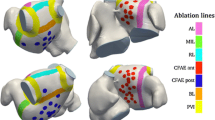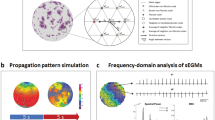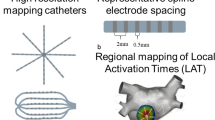Abstract
Human atrial tissue electrophysiology is modeled upon biophysical details obtained from cellular level measurements. Data collected for this purpose typically represent a unique state of the tissue. As reproducing dynamic cases such as subject-varied and/or disorder-varied electrophysiological properties is in question, such complex models are typically hard to use. Hence, there is a need for simpler yet biophysically accurate and mathematically tractable models to be used for case-specific reproductions and simulations. In this study, a scheme for parameter estimation of a phenomenological cardiac model to match a targeted behavior generated from a complex model is used. Specifically, an algorithm incorporating extended Kalman filter (EKF) into the scheme is proposed. Its performance is then compared to that of particle swarm optimization (PSO) and sequential quadratic programming (SQP), algorithms that have been widely used for parameter optimization. Both robustness and adaptability performance of the algorithms are tested through various designs. For this, reproducing action potential (AP) waveforms of varying remodeling states of atrial fibrillation (AF) at different stimulus protocols was targeted. Also, randomly generated initial parameter sets are included in the tests. In addition, AP duration (APD) restitution curve (RC) is used for a multiscale evaluation of fitting performance. Finally, wavefront propagation on 2D of a selected AF remodeling state using parameter solutions from each of the algorithms is simulated for a qualitative evaluation. In general, PSO yielded superior performances than EKF and SQP with respect to fitting AP waveforms. Considering both AP and APD RC, however, EKF yielded the best accuracies. Also, more accurate spiral wave reentry is obtained with EKF. Overall, EKF algorithm yielded the best performance in robustness and adaptability.

Graphical Abstract














Similar content being viewed by others
References
Akhavan Niaki F, Mears L (2017) A probabilistic-based study on fused direct and indirect methods for tracking tool flank wear of rene-108, nickel-based alloy. In: Proceedings of the institution of mechanical engineers, part b: journal of engineering manufacture p 0954405416683432
Alagoz C, Phatharodom S, Guez A (2015) Parameter estimation of a phenomenological cardiac model based on a biophysically detailed model of human atria: a method for model complexity reduction using extended Kalman filter. In: 2015 6th international conference on modeling, simulation, and applied optimization (ICMSAO), IEEE, pp 1–6
Arora S, Singh S (2017) An effective hybrid butterfly optimization algorithm with artificial bee colony for numerical optimization. IJIMAI 4(4):14–20
Beeler GW, Reuter H (1977) Reconstruction of the action potential of ventricular myocardial fibres. J Physiol 268(1):177–210
Berrier KL, Sorensen DC, Khoury DS (2004) Solving the inverse problem of electrocardiography using a duncan and horn formulation of the kalman filter. IEEE Trans Biomed Eng 51(3):507–515
Boutjdir M, Le Heuzey J, Lavergne T, Chauvaud S, Guize L, Carpentier A, Peronneau P (1986) Inhomogeneity of cellular refractoriness in human atrium: factor of arrhythmia? Pacing and clinical electrophysiology: PACE 9(6 Pt 2):1095
Boyd S, Vandenberghe L (2004) Convex optimization. Cambridge University Press, Cambridge
Bueno-Orovio A, Cherry EM, Fenton FH (2008) Minimal model for human ventricular action potentials in tissue. J Theor Biol 253(3):544–560
Chen F, Chu A, Yang X, Lei Y, Chu J (2012) Identification of the parameters of the beeler–reuter ionic equation with a partially perturbed particle swarm optimization. IEEE Trans Biomed Eng 59(12):3412–3421
Cherry EM, Ehrlich JR, Nattel S, Fenton FH (2007) Pulmonary vein reentry—properties and size matter: insights from a computational analysis. Heart Rhythm 4(12):1553–1562
Clerc M, Kennedy J (2002) The particle swarm-explosion, stability, and convergence in a multidimensional complex space. IEEE Trans Evol Comput 6(1):58–73
Courtemanche M, Ramirez RJ, Nattel S (1998) Ionic mechanisms underlying human atrial action potential properties: insights from a mathematical model. Am J Physiol Heart Circ Physiol 275(1):H301–H321
Courtemanche M, Ramirez RJ, Nattel S (1999) Ionic targets for drug therapy and atrial fibrillation-induced electrical remodeling: insights from a mathematical model. Cardiovasc Res 42(2):477–489
Dokos S, Lovell NH (2004) Parameter estimation in cardiac ionic models. Prog Biophys Mol Biol 85 (2):407–431
Eberhart R, Kennedy J (1995) A new optimizer using particle swarm theory. In: 1995. MHS’95., Proceedings of the Sixth international symposium on micro machine and human science, IEEE, pp 39–43
Feinberg WM, Blackshear JL, Laupacis A, Kronmal R, Hart RG (1995) Prevalence, age distribution, and gender of patients with atrial fibrillation: analysis and implications. Arch Intern Med 155(5):469–473
Fenton F, Karma A (1998) Vortex dynamics in three-dimensional continuous myocardium with fiber rotation: filament instability and fibrillation. Chaos: An Interdisciplinary Journal of Nonlinear Science 8(1):20–47
Fink M, Noble D (2009) Markov models for ion channels: versatility versus identifiability and speed. Philosophical Transactions of the Royal Society of London A: Mathematical. Phys Eng Sci 367(1896):2161–2179
Fletcher R (2013) Practical methods of optimization. Wiley, Hoboken
Goodman AM, Oliver RA, Henriquez CS, Wolf PD (2005) A membrane model of electrically remodelled atrial myocardium derived from in vivo measurements. EP Europace 7(s2):S135–S145
Groenendaal W, Ortega FA, Kherlopian AR, Zygmunt AC, Krogh-Madsen T, Christini DJ (2015) Cell-specific cardiac electrophysiology models. PLoS Comput Biol 11(4):e1004,242
Guo T, Al Abed A, Lovell NH, Dokos S (2013) Optimisation of a generic ionic model of cardiac myocyte electrical activity. Comput Math Methods Med 2013:20. https://doi.org/10.1155/2013/706195
Hobbs F, Fitzmaurice D, Mant J, Murray E, Jowett S, Bryan S, Raftery J, Davies M, Lip G (2005) A randomised controlled trial and cost-effectiveness study of systematic screening (targeted and total population screening) versus routine practice for the detection of atrial fibrillation in people aged 65 and over. the safe study. Health Technol Assess (Winch Eng) 9(40):iii
Hodgkin AL, Huxley AF (1952) A quantitative description of membrane current and its application to conduction and excitation in nerve. J Physiol 117(4):500–544
Jiang K, Geng P, Meng F, Zhang H (2016) An extended kalman filter for input estimations in diesel-engine selective catalytic reduction applications. Neurocomputing 171:569–575
Kalman RE (1960) A new approach to linear filtering and prediction problems. J Fluids Eng 82(1):35–45
Kennedy J (2011) Particle swarm optimization. In: Encyclopedia of machine learning, Springer, pp 760–766
Kopp RE, Orford RJ (1963) Linear regression applied to system identification for adaptive control systems. AIA J 1(10):2300–2306
Krogh-Madsen T, Abbott GW, Christini DJ (2012) Effects of electrical and structural remodeling on atrial fibrillation maintenance: a simulation study. PLoS Comput Biol 8(2):e1002,390
Kumar DD, Narasimhan S, Bhatt N (2016) Diagnosis and rectification of model-process mismatch in chemical reaction systems. In: Control conference (ICC), 2016 indian, IEEE, pp 140–145
Liu F, Walmsley J, Burrage K (2011) Parameter estimation for a phenomenological model of the cardiac action potential. ANZIAM Journal 52:482–499
Mase M (2017) Application of computer models on atrial fibrillation research. Minerva Cardioangiol 65 (4):398–419
Metia S, Oduro SD, Duc HN, Ha Q (2016) Inverse air-pollutant emission and prediction using extended fractional kalman filtering. IEEE Journal of Selected Topics in Applied Earth Observations and Remote Sensing 9 (5):2051–2063
Meza J, Espitia H, Montenegro C, Giménez E, González-Crespo R (2017) Movpso: Vortex multi-objective particle swarm optimization. Appl Soft Comput 52:1042–1057
Mitchell CC, Schaeffer DG (2003) A two-current model for the dynamics of cardiac membrane. Bull Math Biol 65(5):767–793
Niaki FA, Michel M, Mears L (2016) State of health monitoring in machining: Extended Kalman filter for tool wear assessment in turning of in718 hard-to-machine alloy. J Manuf Process 24:361–369
Nygren A, Fiset C, Firek L, Clark J, Lindblad D, Clark R, Giles W (1998) Mathematical model of an adult human atrial cell the role of k+ currents in repolarization. Circ Res 82(1):63–81
Oliver RA, Krassowska W (2005) Reproducing cardiac restitution properties using the fenton–karma membrane model. Ann Biomed Eng 33(7):907–911
Ranucci M, Porta A, Bari V, Pistuddi V, La Rovere MT (2017) Baroreflex sensitivity and outcomes following coronary surgery. PloS One 12(4):e0175,008
Rhodes IB (1971) A tutorial introduction to estimation and filtering. IEEE Trans Autom Control 16(6):688–706
Ruan X, Ding M, Gong D, Qiao J (2007) On-line adaptive control for inverted pendulum balancing based on feedback-error-learning. Neurocomputing 70(4):770–776
Schittkowski K (1986) Nlpql: a fortran subroutine solving constrained nonlinear programming problems. Ann Oper Res 5(1): 485–500
Seemann G, Bustamante PC, Ponto S, Wilhelms M, Scholz EP, Dössel O. (2010) Atrial fibrillation-based electrical remodeling in a computer model of the human atrium. Comput Cardiol 37: 417–420
Shi Y, Eberhart R (1998) A modified particle swarm optimizer. In: 1998. IEEE world congress on computational intelligence., the 1998 IEEE international conference on Evolutionary computation proceedings, IEEE, pp 69–73
Simon D (2010) Kalman filtering with state constraints: a survey of linear and nonlinear algorithms. IET Control Theory Appl 4(8):1303–1318
Sobie EA (2009) Parameter sensitivity analysis in electrophysiological models using multivariable regression. Biophys J 96(4):1264–1274
Sum J, Leung CS, Young GH, Kan WK (1999) On the kalman filtering method in neural network training and pruning. IEEE Trans Neural Netw 10(1):161–166
Syed Z, Vigmond E, Nattel S, Leon L (2005) Atrial cell action potential parameter fitting using genetic algorithms. Med Biol Eng Comput 43(5):561–571
Trayanova NA (2014) Mathematical approaches to understanding and imaging atrial fibrillation: significance for mechanisms and management. Circ Res 114(9):1516–1531
Zhou Q, Zygmunt AC, Cordeiro JM, Siso-Nadal F, Miller RE, Buzzard GT, Fox JJ (2009) Identification of i kr kinetics and drug binding in native myocytes. Ann Biomed Eng 37(7):1294– 1309
Author information
Authors and Affiliations
Corresponding author
Appendices
Appendix A: Minimal model equations
The states for minimal model is as follows:
where u is membrane voltage, v, w, and s are gating variables. Here u is dimensionless.
Three currents are defined as follows:
where Ifi is the fast inward, Iso is the slow outward, Isi is the slow inward current, and H(x) is the standard Heaviside function. The time constants are defined as follows:
and the infinite values are defined as follows:
Appendix B: Minimal model parameter regimes
Certain boundaries for each parameter is used in this study. Boundary for each parameter is determined in succession using following procedure. The parameter whose boundaries to be determined is varied as all other parameters are fixed in their nominal values. Through variation corresponding AP waveforms are generated and whenever a non-physiological AP is produced, the value before that is set as the boundary. The variation was towards the both directions, plus and minus infinity, from the nominal value. Resolution of variation differed accordingly with the magnitude of the nominal value of varied parameter. Endocardium parameter set provided in [8] is used as nominal parameter values.
Non-physiology of AP is detected based on certain criteria: (i) whenever APD is less than 90 ms or greater than 350 ms, (ii) whenever the value of u is greater than 1.8 during early repolarization phase, (iii) whenever the value of u is greater than 1.5 during the phases other than early repolarization.
The correlations between the parameter groups are neglected in this study to simplify the assessment of boundary regime. Also, sensitivity of a certain parameter is expected to depend on a few number of other parameters since each phase of AP waveform in MM is governed by distinct clusters of parameters. However, parameter sensitivity of MM requires another independent study which is the beyond the scope of this one.
Rights and permissions
About this article
Cite this article
Alagoz, C., Phatharodom, S. & Guez, A. Complexity reduction in human atrial modeling using extended Kalman filter. Med Biol Eng Comput 57, 777–794 (2019). https://doi.org/10.1007/s11517-018-1921-1
Received:
Accepted:
Published:
Issue Date:
DOI: https://doi.org/10.1007/s11517-018-1921-1




